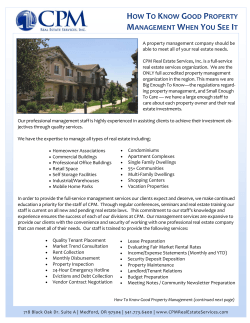
Media Strategy Professor Close & Professor Dudo,
Media Strategy Professor Close & Professor Dudo, The University of Texas at Austin CASE: HEALTHY DOG GOURMET Guidance: • Please create a media schedule and CPM analysis prior to making your decision • I will provide these and go over them • Don’t be constrained by the client’s media plan (i.e., your client is not always right- why are they hiring you?) • Keep the client budget in mind- do not go over this or recommend them to increase the budget • A 10% contingency is appreciated IBP PROCESS Situation Analysis Measurable Objectives Budget Creative Strategy Media Strategy TAKE HOME MESSAGE Even the best messages will be useless if they don’t reach the target audience SET A MEDIA OBJECTIVE “To reach 60% of males aged 25-35 that are cycling enthusiasts 3 or more times each month during the first 6 months of the introduction of a new product.” Address the psychographic and demographic target market and find the media that matches the market best given your budget MEDIA PLANNING Media Plan Specifies media in which advertising message will be placed to reach desired audience(s). Media Class A single form of communication (TV, radio). Media Vehicle Specific option within a class (Nat Geo mag). Media Mix Blend of different media to reach target audience. MEDIA PLANNING Many choices to allocate among: TV Magazine Radio Newspaper Outdoor Etc. MEDIA PLANNING Above-the-line: Traditional measured media (TV, radio, NPs, etc.) Below-the-line: Unmeasured media/IBP tools (more efficient) CHANGES IN MEDIA PLANNING More media: Traditional media lines are blurred Firms push “news” stories into media Movies/videos can be promotional vehicles Social media offer new (cheap) opportunities CHANGES IN MEDIA PLANNING Globalization: Media now exists in transnational space Search engines don’t care about geography Free content: Consumers now used to free content Nontraditional media are attracting more $ CHANGES IN MEDIA PLANNING Consumer in charge: Marketers no solely in charge of brand; consumers have more power Clutter & ad avoidance: Consumers choosing no-ad channels (e.g., radio) and have new tools (e.g., DVR) People will to pay to avoid ads THE OVERALL MEDIA PLAN SETTING MEDIA OBJECTIVES ID target audience Geographic Mkt Timing & Continuity Media fit Size & length MEDIA SELECTION PROCEDURES Reach Frequency GRP, CPM… SETTING MEDIA OBJECTIVES 1. Identify target audience: Must find similarities between the target market and media audience Not easy! … apples & oranges problem “Oops!” potential SETTING MEDIA OBJECTIVES Kids love me! SETTING MEDIA OBJECTIVES 2. Select geographic market: Demand varies; sales are seldom consistent everywhere Means that ADV must vary according to geographic locations Geo-targeting SETTING MEDIA OBJECTIVES TIMING & CONTINUITY STRATEGIES Continuous Spread ADV continuously and evenly over the length of the campaign Pulsing Intensify ADV before an open aperture then reduce ADV until the next open aperture Flighting Alternating periods of intense ADV and periods of no ADV SETTING MEDIA OBJECTIVES Campaign time Anthony Dudo © Flighting $ Spent $ Spent Pulsing Campaign time SETTING MEDIA OBJECTIVES Chosen media must be compatible with the advertising strategy 4. Media fit: Chose media must reflect positively on the brand – the tone must be appropriate The source itself can have an effect SETTING MEDIA OBJECTIVES SETTING MEDIA OBJECTIVES Must determine the appropriate size (static) or length (broadcast) of the ad 5. Size & length: Research is inconclusive Choose size & length based on objectives Ex) awareness = short spot knowledge = long spot MEDIA SELECTION STRATEGIES When selecting the specific ADV media: Reach – the # of different people exposed to the message Frequency – the degree of exposure repetition Must determine the efficiency of different media vehicles MEDIA SELECTION STRATEGIES SOME STANDARD MEASURES FOR SELECTING MEDIA Impression – one person’s opportunity to be exposed to an ad Gross Impressions: Impressions are a measure of the size of the audience for one media or a combo of media vehicles Gross impressions are the sum of the audiences of all media vehicles during a certain span of time MEDIA SELECTION STRATEGIES SOME STANDARD MEASURES OF EFFICIENCY Media Vehicle Target Impressions Number of Ads Total Target Impressions David Letterman Show 500,000 4 2,000,000 The Colbert Report 1,000,000 3 3,000,000 Gross 5 Million Impressions = MEDIA SELECTION STRATEGIES SOME STANDARD MEASURES FOR SELECTING MEDIA AKA – cost per thousand (CPM) Efficiency: Unlike impressions, CPM is focused on cost Given cost constraints, media is selected that will expose the largest target audience for the lowest price MEDIA SELECTION STRATEGIES SOME STANDARD MEASURES FOR SELECTING MEDIA AKA – cost per thousand (CPM) Efficiency: Unlike impressions, CPM is focused on cost Given cost constraints, media is selected that will expose the largest target audience for the lowest price MEDIA SELECTION STRATEGIES SOME STANDARD MEASURES FOR SELECTING MEDIA Cost of media buy CPM = X 1000 Total target audience MEDIA SELECTION STRATEGIES SOME STANDARD MEASURES FOR SELECTING MEDIA Magazine example: An issue of Real Simple has 2M readers who could be considered a target audience. The advertising unit is a four-color page with a rate of 15K. $15,000 CPM = X 1000 2,000,000 $7.50 THE LAY OF THE LAND THE LAY OF THE LAND MEDIA PLANNING: SOCIAL MEDIA Social Networking: New paradigm in media planning Marketer (brand) to consumer, then consumer to consumer Marketers can use social media at a fraction of the cost of traditional media Social media used to create “buzz” or “viral” effect IN DEFENSE OF TRADITIONAL ADVERTISING There are some things you just can’t accomplish without traditional mass media advertising The Super Bowl and Olympics deliver a truly MASS audience Brand building still needs traditional ads … for now MAIN PURPOSE OF THE MEDIA PLAN To deliver the right message to the appropriate target audience as many times as necessary to achieve the goals of the advertising campaign
© Copyright 2025





















